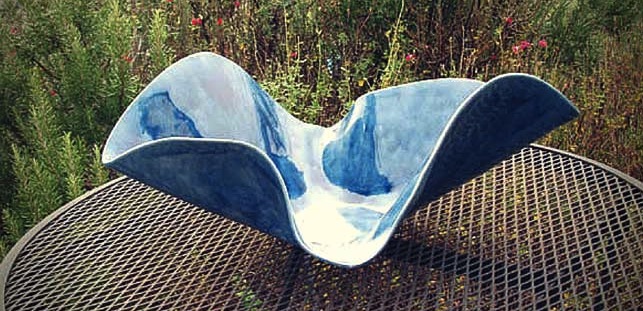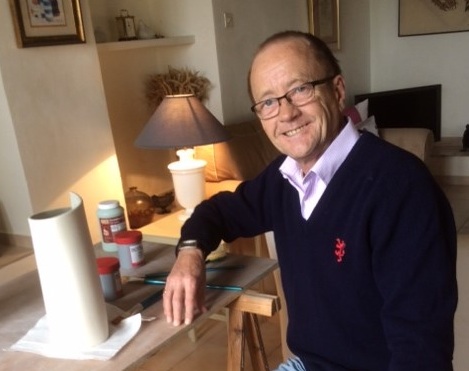When did you first start working with ceramics?
I studied ceramics at Westminster College in the mid 80’s, when I was in my mid 20’s. I soon realised that I was rubbish at the wheel – spent most of my time cleaning up than making a pot - so I focused on slab and coil.
I was fascinated by the fact that you could take raw clay and make it into a permanent object.
Maybe it was the start of my fascination of archaeology and an appreciation of the fact that everything we take for granted was designed and made by some individual.
"My hope is that one day my work will be dug up by Time Team and displayed in the British Museum. Heaven knows there are enough rejects to pave a driveway before I get the result I want! "
In the early 90’s I put my ceramic career on the back shelf and spent almost 25 years in IT until ending it in 2012 when I decided I wanted to get back to ceramics again.
Do you have a studio space you work from, tell us about it.
At the moment I work from home, in South West France, on trestle tables in my sitting room. My two kilns are in our barn where I also have a homemade slab roller and a pug mill.
We would love to sell our current property and move to some place smaller where I could have a proper workshop. I take on enthusiastic students from time to time but it is awkward and I have pots and bowls in various stages of drying, or bisque ware all over the house.
Are there any new mediums or techniques that interest you?
I am fascinated by crystal glazes and porcelain but I don’t think my kilns are up to the rapid cooling required to make it all work.
I also fancy experimenting with pigments to colour my clay and creating multi-coloured clay bowls and vases.
What aspect of your work do you enjoy the most?
I like the challenge of pushing the medium to the limits.
I roll the clay out and leave it to dry slightly before I start looking at it. I don’t have preset ideas of what I am going to make when I start working, well not always.
The joy comes when I start working on the slab in front of me and it becomes a tangible object, be that a vase, bowl or some other form.
I allow the clay to dictate what it wants to be and I go with the flow and then push one extra mile. I love the “what if” aspect of it all. It doesn’t always work, but that’s half the fun. The other half is at the end when I open the kiln after a glaze firing and see all the brilliant colours and completed pieces – its Christmas every time!
What is the main inspiration for your designs?
I like the designs from the 1920’s and 1930’s and art nouveau with its fluid forms and natural lines.
What I love to do is slumping; where you take a slab of clay and literally drop it over something, such as a tall jar, and let the clay sag and then support it with books or CD cases to give it form. Once it has dried simply turn it over and you have a bowl.

Do you have any anecdotes to share about your work?
In the 80’s I made a series of plaster bowls by scrunching up aluminium foil and then pulling it apart but keeping the scrunch. I then pushed the foil into a plastic bowl and poured plaster into it and swirled it around.
When it dried I took the plaster cast out of the bowl and very carefully removed the foil, painted the bowl in bright colours such as acid yellow, lime green etc and varnished them.
They were extremely delicate but rather lovely.
I thought I could do this in ceramic, so started the process again and used slip instead of plaster. Of course it didn't work because plaster goes off much faster than slip.
I needed to re-think, so I applied the same technique to making tiles. Instead of using a bowl I used a baking tray and poured the slip over the foil and set it aside to dry. Of course, removing the foil from very thin dry clay means that the tile broke 10 times out of 10 so I ended up with bits of crinkly chunks of clay. Not to be put off I fired them and then glazed them with lustre glazes in platinum, gold and bronze. I then glued the bits to a painted canvas so they could be hung.
A brilliant idea but when I was working on glazing several pieces a friend of mine called by and saw what I was doing and said “so don’t you ever make anything that is not broken or useful?”

Do you have a favourite piece you've made?
I said earlier that I allow the clay to take the lead and then push that extra mile. Well 2014 was the exception to that approach.
I had a design in my head for a vase that would not go away no matter what. I tried and tried to make this vase, ending in total failure each time.
Each attempt failed at different stages of construction. Either during the wet clay construction, during the drying process or bisque firing. It was extremely frustrating but no matter what I did it was not working.
The image would not go away even when I thought I would make something else it still turned into this one vase. I did manage it and I called the vase Number 15, like 7 up, it was the 15th attempt and it worked sort of.
The glaze over ran and the base was covered in excess glaze and needed removing. I could either angle grind the base and risk destroying the vase or I could research other techniques.
A close friend and fellow ceramist suggested diamond pads as an alternative to remove the glaze.
"I searched the web and found Eternal Tools. I bought the diamond hand pads from them and I will never regret it. They worked; my vase is intact and now has been sold much to my sadness, because I know I will never be able to create it again"
After all that effort and angst it is like losing a special friend, but I am pleased that the person who bought it is in love with it as much as I am.
Tell us about where you sell your work and any upcoming exhibitions.
I exhibit 2 or 3 times a year locally here in France. I am a member of an art association which currently has 7 or 8 members. Most of the artists are painters but there is one other ceramist in the group but her work is totally different to mine.
We have 3 exhibitions this year so go to www.artaquitaine.com if you are interested.
Our flagship exhibition is at Castillonnes and the opening night is attended by lots of local dignitaries including the Mayor and his wife. It is great fun and a wonderful party to boot.
What tool could you not live without?
The one tool I really can’t live without is my fettling knife.
They come in two forms, rigid and subtle. I use the latter which allows me to bend the blade to any angle so I can cut into the most awkward corners and then straighten it out again for more standard cutting.
I think the second tool if I am allowed is my slab roller. Homemade, and a great asset when you work with slab work.
What's the best piece of advice you can give to someone wanting to start up their own art business?
Start small but well equipped.
There is nothing more frustrating than not having the right tools for the job at hand. Look around and see what others are doing, and see if you can identify a unique angle that you can exploit and talk to someone about marketing.
All my adult life I have been lucky to be paid for doing my hobby.
Love what you do and do what you love - The best result you can ever get.
What's next for artinceramic.com?
I am always looking for new venues to exhibit at. It is a lot cheaper than running a retail outlet after all.
I try to create new things each year. This year I am focused on vases in bright colours and the odd bowl or two.
After that who knows!

Well, a huge thank you to Raymond for not only giving us some top tips on removing glaze and for sharing his work with us, but also for making us chuckle.
If you'd like to see more of Raymond's work and see his excellent painting as well, visit his website at: http://www.artinceramic.com/
If you're looking to remove glaze without the use of a grinder, try a diamond hand pad.


